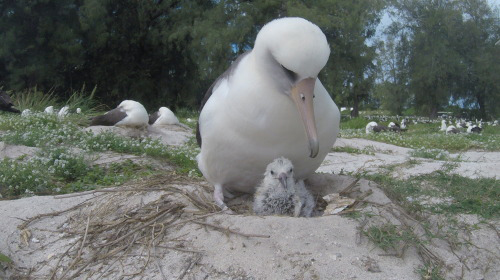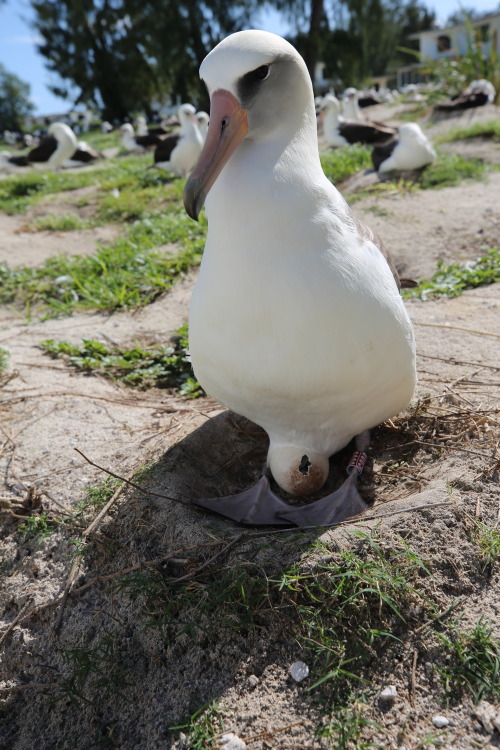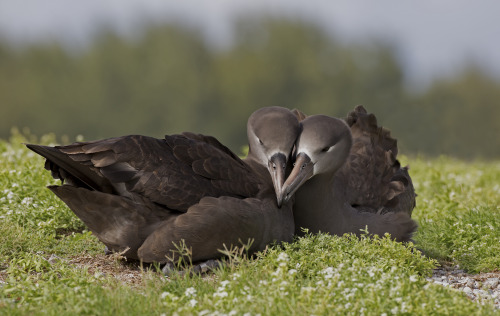
Wisdom’s mate Akeakamai stands over their newly hatched chick. Photo by Bob Peyton / USFWS
February 10, 2019 - Wisdom, a Laysan albatross and world’s oldest known, banded wild bird has hatched a new chick at Midway Atoll National Wildlife Refuge and Battle of Midway National Memorial. She is at least 68 years old, has raised between 31-36 chicks in her lifetime, and is still going!
Wisdom was first sighted at her nest site on November 29, 2018 and laid an egg soon after. It is uncommon for albatross to return to, lay, and hatch an egg every single year. However, Wisdom and her mate have done this at Midway Atoll in Papahānaumokuākea Marine National Monument each year since 2006.

Wisdom’s mate Akeakamai stands over his pipping egg - the chick is starting to hatch. Photo by Bob Peyton / USFWS
Albatross spend 90% of their life at sea where they soar over the ocean for days on end and rest on the waves to feed on squid and fish eggs. And all albatross return nearly every year to the place they were born. Millions of albatross return to Midway Atoll each year to nest and raise their young. This behavior is known as “nest site fidelity” and it makes places with large colonies of nesting birds, like Midway Atoll, critically important for the future survival of seabirds like Wisdom. In 2017, the chick that she fledged in 2001 was observed just a few feet away from her current nest, marking the first time a returning chick of hers has been documented.
“She’s incredibly powerful as a symbol of why we do what we do and why people all over the world pay attention to her,” said Beth Flint, U.S. Fish and Wildlife Service Wildlife Biologist. Wisdom is rewriting history about our understanding of “survivorship, how long birds live, and how often they breed.”
Raising Albatross Chicks
Raising the next generation of albatross is no easy job. Albatross return starting in October to meet their mate, and will spend approximately seven months on Midway Atoll to incubate and raise their chick. Albatrosses lay a single egg and both parents take turns incubating it for a little over two months. When not on parenting duty, Wisdom and Akeakamai take turns foraging for food. After the chick hatches, another five to six months will pass before it leaves the island to fly out to sea, or “fledge”. This process takes up so much time and energy, so most Laysan albatross do not lay an egg every year.
“Because Laysan albatross don’t lay eggs every year and when they do, they raise only one chick at a time, the contribution of even one bird to the population makes a difference,” said Bob Peyton, U.S. Fish and Wildlife Service Project Leader for Midway Atoll Refuge and Memorial.
For the first years of their lives, albatross grow and mature at sea. Starting around age five, juvenile Laysan return to their home colony during breeding season and begin the search for a mate - a process that can take years. During nesting season, juvenile albatross can be found all over Midway Atoll practicing elaborate courtship dances or dozens of ritualized movements. When they find that special bird to dip, bow, and preen with, the pair stays bonded for life.
A pair of Black-footed albatross perform a courtship dance surrounded by chicks sitting on nests. Video by USFWS
Conserving Albatross’ Home
There aren’t many places left for Laysan Albatross to nest, and Midway Atoll is by far the most important Laysan Albatross colony in the world. Nearly 70% of the world’s Laysan albatross, almost 40% of Black-footed albatross, and endangered Short-tailed albatross all rely on Midway Atoll. In addition to albatross, there are 20 different bird species that live on Midway Atoll. In total, over three million individual birds call the Refuge and Memorial home.

A pair of Black-footed albatross sit and nestle together. Photo by Dan Clark / USFWS
Throughout the Monument, scientific research and monitoring plays an essential role in managing wildlife, including seabirds. Surveys and banding projects conducted in the Monument and throughout the world help scientists better understand the life cycles and migration patterns of birds. Wisdom was first identified and banded by biologists as an adult in 1956, but the very first albatross was banded on Midway Atoll in 1936. To date over 250,000 albatross have been banded at the Refuge and Memorial. By pairing modern data analysis with detailed current and historical records, biologists can make more informed management decisions that ensure seabirds have the habitat and resources they need in the future.
Biologists with the U.S. Fish and Wildlife Service are working to restore the habitat seabirds need at Midway Atoll and remove threats like invasive predators - because protecting the future for seabirds mean protecting the places they call home.
Follow Wisdom’s story on Facebook and Twitter!
For more photos and video, please visit: https://goo.gl/ucVV7f
Read more stories about Midway Atoll and the Albatross at:
Wisdom Returns to Midway - December 2018
Midway’s Albatross: A New Threat Puts the World’s Largest Colony at Risk
Video: Battle of Midway Commemoration Film
The Return of Midway’s Albatross
The Laysan Albatross: A Lovesong
Midway Atoll: Restoring an Ecological Gem
A Future to Count on for Albatross at Midway NWR
Discovering Midway’s Cultural History
War and Peace at Midway Atoll National Wildlife Refuge and Battle of Midway National Memorial
Return to Midway: A short-tailed albatross love story
“Lonesome” George Finds a Friend
Located on the far northern end of the Hawaiian archipelago, Midway Atoll Refuge and Memorial is managed by the U.S. Fish and Wildlife Service and located within the Papahānaumokuākea Marine National Monument. It is one the oldest Atoll formations in the world, it provides nesting habitat for millions of seabirds, and it is a touchstone for one of the most significant naval battles of World War II, and in history, the Battle of Midway. To learn more about the Midway Atoll: https://www.fws.gov/refuge/midway_Atoll/
Papahānaumokuākea is cooperatively managed to ensure ecological integrity and achieve strong, long-term protection and perpetuation of Northwestern Hawaiian Island ecosystems, Native Hawaiian culture, and heritage resources for current and future generations. Four co-trustees - the Department of Commerce, Department of the Interior, State of Hawai‘i and the Office of Hawaiian Affairs - protect this special place. Papahānaumokuākea Marine National Monument was inscribed as the first mixed (natural and cultural) UNESCO World Heritage Site in the United States in July 2010. For more information, please visit www.papahanaumokuakea.gov.
Source: U.S. FWS
Related Information: World’s Oldest Wild Bird Returns to Midway!
